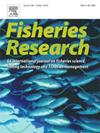从大规模标记研究中发现,河口相关的疏叶棘南棘的运动模式和驱动因素
IF 2.3
2区 农林科学
Q2 FISHERIES
引用次数: 0
摘要
鱼类运动的知识对于实施适当的种群评估和管理的空间尺度至关重要。本研究利用合作标签再捕获项目的数据,研究了澳大利亚东海岸一种重要的渔业物种——南棘鱼(Acanthopagrus australis)——黄鳍鲷的运动模式。在大约800 公里的海岸线上,有24,000多只被标记并释放,在19年的时间里,休闲垂钓者重新捕获了2,036只(8.2% )。虽然观察到的移动范围很广(0-832 公里),但只有8.6% %的鱼移动超过100 公里,而且相当大比例(37 %)的个体在放归地点被重新捕获。广义加性模型表明,如果鱼自由活动的时间更长,放生时体长更大,并且在秋季放生,它们就更有可能移动。如果鱼向北移动,自由活动的时间更长,在更南纬的地方放生,则游动距离更大。结果表明,黄鳍鱼的活动在相对较小的空间尺度上受到限制(<;100 km),偶尔有较大的运动,与多种行为类型一致。研究结果表明,为了确保可持续的渔业管理,在更精细的空间尺度上进行监测、评估和管理可能比目前的全州范围的方法更有必要。本文章由计算机程序翻译,如有差异,请以英文原文为准。
Patterns and drivers of movement in the estuary-associated sparid Acanthopagrus australis from a large-scale tagging study
Knowledge of fish movement is essential for implementing appropriate spatial scales of stock assessment and management. This study examines the movement patterns of an important fisheries species Acanthopagrus australis, yellowfin bream, along Australia’s east coast using data from a cooperative tag-recapture program. More than 24, 000 individuals were tagged and released across ∼ 800 km of coastline, with recreational anglers recapturing 2, 036 (8.2 %) individuals during a 19-year period. While a broad range of movements was observed (0–832 km), only 8.6 % of fish moved further than 100 km and a substantial proportion (37 %) of individuals were recaptured at their release location. Generalized additive models indicated that fish were more likely to move if they spent greater time at liberty, were of larger body length at release, and were released during Autumn. Movement distance was greater if fish moved in a northerly direction, spent greater time at liberty and were released at more southerly latitudes. The results indicate that movement of yellowfin bream is restricted over a relatively small spatial scale (< 100 km), with occasional larger movements consistent with multiple behavioural types. The findings suggest that monitoring, assessment and management at a finer spatial scale than the current state-wide approach may be warranted to ensure sustainable fisheries management.
求助全文
通过发布文献求助,成功后即可免费获取论文全文。
去求助
来源期刊

Fisheries Research
农林科学-渔业
CiteScore
4.50
自引率
16.70%
发文量
294
审稿时长
15 weeks
期刊介绍:
This journal provides an international forum for the publication of papers in the areas of fisheries science, fishing technology, fisheries management and relevant socio-economics. The scope covers fisheries in salt, brackish and freshwater systems, and all aspects of associated ecology, environmental aspects of fisheries, and economics. Both theoretical and practical papers are acceptable, including laboratory and field experimental studies relevant to fisheries. Papers on the conservation of exploitable living resources are welcome. Review and Viewpoint articles are also published. As the specified areas inevitably impinge on and interrelate with each other, the approach of the journal is multidisciplinary, and authors are encouraged to emphasise the relevance of their own work to that of other disciplines. The journal is intended for fisheries scientists, biological oceanographers, gear technologists, economists, managers, administrators, policy makers and legislators.
 求助内容:
求助内容: 应助结果提醒方式:
应助结果提醒方式:


